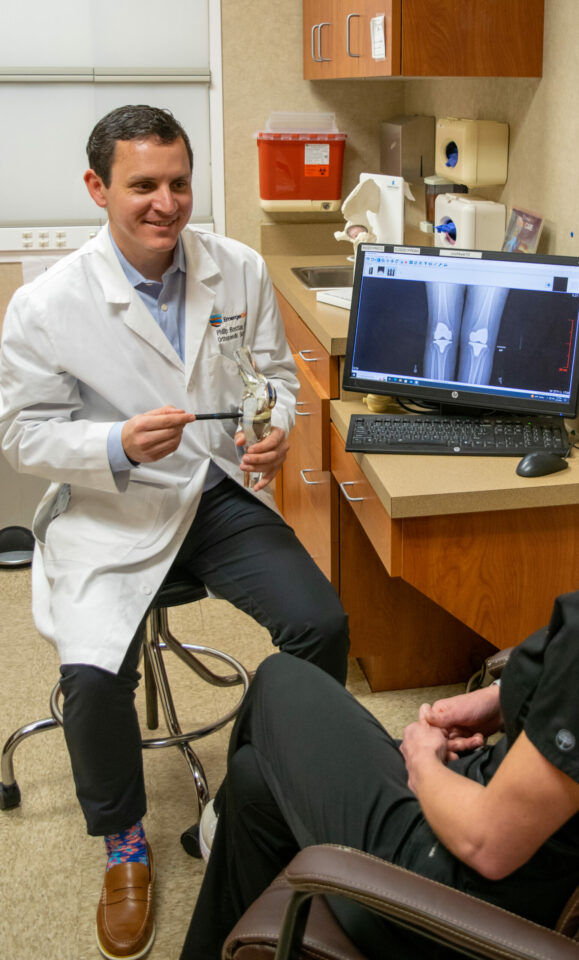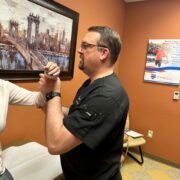
The knee is a complex and large joint susceptible to injuries. From athletes to mostly sedentary people and anyone at any age, different knee injuries are common. They can be mild or debilitating but are always treatable. Common types of knee injuries include sprains, strains, fractures, and dislocations.
A Quick Look at the Parts of the Knee

The knee is the largest joint in the body. It bears a lot of weight and is responsible for many different movements. The anatomy of the knee includes bones, tendons, and ligaments, all susceptible to injury:
- Femur. The femur is the upper leg bone.
- Tibia. The tibia is the shin bone, the lower leg bone at the front.
- Patella. The patella is the kneecap that sits at the front of the knee.
- Meniscus. Two pads of cartilage (the menisci) sit between the tibia and femur to provide cushioning. The lateral meniscus is on the outside of the joint, and the medial is on the inside.
- Collateral Ligaments. The lateral and medial collateral ligaments (LCL and MCL) connect the femur and tibia on the outside and inside of the knee. They help maintain side-to-side stability in the joint.
- Anterior and Posterior Cruciate Ligaments. The ACL and PCL connect the femur and tibia front-to-back, crossing each other in an X-shape. The ACL keeps the knee and tibia from moving too far forward. The PCL protects the knee from excessive backward movement.
- Quadriceps Tendon. This tendon connects the quadriceps muscle at the front of the thigh to the patella.
- Patellar Tendon. Also called a ligament, this connects the patella to the tibia.
The knee joint is held together by a capsule. The outer layer of the capsule is ligament. The inner layer is called the synovium, which secretes lubricating fluid.
Ligament Injuries
While any ligament in the knee is vulnerable, the ACL is most often injured. Knee ligament injuries are especially common in sports. ACL injuries result from overextension, twisting and turning, and quick stops and starts. PCL and collateral ligament injuries are usually caused by blows to the front or side of the joint during sports, a fall, or a car accident.
Ligament injuries are graded by severity:
- Grade I ligament injuries are sprains and overstretching of the ligament. They cause mild pain and swelling, if any at all.
- Grade II injuries cause partial tears in the ligament fibers. These injuries result in some swelling, restricted movement, and more pain.
- Grade III injuries occur when the ligament tears completely. It causes severe pain at the time of the injury, a lot of swelling and bruising, and extreme instability in the joint.
Meniscus Tears
Meniscus tears are also common sports injuries. Jumping and twisting can tear the cartilage. This causes pain and swelling on the inside or outside of the knee joint depending on which meniscus is involved. Menisci weakened by age or arthritis can easily tear during normal daily activities.
Knee Dislocation
Dislocations occur when any of the bones of the knee joint come out of place. A dislocation can be partial or complete. It may involve the patella, the femur, or the tibia.
A dislocation can happen easily in someone with knee abnormalities. Heavy trauma usually causes dislocations in people with a normal knee structure: falls, car accidents, or contact in sports.
A dislocated patella is usually accompanied by a popping sound, intense pain, and instability in the knee. A tibiofemoral dislocation also causes severe pain, instability, and an inability to bend at the knee.
Tendon Injuries
Like ligaments, tendons can be overstretched or torn. Patellar tendinitis, also known as jumper’s knee, often occurs in sports with a lot of running or jumping. It causes pain below the kneecap. The quadriceps tendon can also be stretched or torn. This is caused by running, jumping, and blows to the front of the knee. It causes pain above the kneecap.
Patella Fracture
A fall or blow to the kneecap causes a patella fracture. Less commonly, fractures can occur at the ends of the tibia or femur near the knee. Hard blows to the knee cause fractures. These injuries cause significant pain and make it difficult or impossible to straighten the knee or to stand and walk.
Treating Common Knee Injuries
After a knee injury diagnosis, an orthopedic specialist will provide treatment options. These may include immobilization and rest for minor injuries or surgery for more severe injuries. Other treatments that can help include icing, pain medications, and physical therapy.
If you suffered a knee injury or have mild but persistent knee pain, contact EmergeOrtho—Foothills Region to make an appointment with one of our orthopedic knee specialists.







